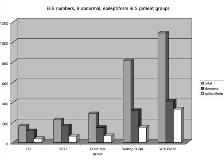DIFFERENT EEG RESULTS IN INPATIENT AND OUTPATIENT, ICU AND OTHER CASES, 2584 CONSECUTIVE EEGS
Abstract number :
1.158
Submission category :
Year :
2003
Submission ID :
1177
Source :
www.aesnet.org
Presentation date :
12/6/2003 12:00:00 AM
Published date :
Dec 1, 2003, 06:00 AM
Authors :
S. Robert Snodgrass Neurology (Pediatrics), Childrens Hospital Los Angeles, Keck/USC Schooll of Medicine, Los Angeles, CA
Nonspecialists often assume that abnormal EEGs have the same meaning in all patients. We find that abnormalities are more frequent in inpatients and that the kinds of abnormalities differ between inpatients and outpatients, sick, ventilated and healthy patients.
Results of all EEGs except Videotelemetry studies performed between July 2001 and Jan 2003 were reviewed. An electrographic seizure is defined as a continuous discharge lasting at least 5 secs.
Most EEGs were outpatient EEGs. Outpatients comprised 73.2% of all studies, 1899 of 2584 during this 18 month period. Fifty-eight percent of all outpatient studies included sleep. Twenty-three were sedated or drug-induced sleep (1.2% of outpatient EEGs). The percentage of normal studies was similar between waking only and waking and sleep (WS) studies: 61.3 and 62.3%, but WS studies included significantly more seizures and epileptiform discharges: 18.7% (W) and 30.3% (WS). Recorded seizures were also more frequent in WS studies: 97 outpatient EEGs included seizures, of which 61% were primary generalized type. Only 14% of 61 inpatient EEGs with seizures had primary generalized seizures. Inpatients on ventilators were 2 1/2 times more likely to have abnormal EEGs than those not on ventilators. Only 2/23 sedated sleep studies showed epileptiform discharges and only 3/28 STAT EEGs (excluding brain death studies) included seizures or major background abnormalities. If we exclude NICU patients, we were more likely to obtain sleep in outpatients (58%) than inpatients (39%).[figure1]
Sick inpatients more often have abnormal EEGs than outpatients, but less often have epileptiform EEGs. Six percent of EEGs included seizures; seizure types were different in inpatients and outpatients. Outpatient EEGs including natural sleep had a higher incidence of epileptiform abnormalities than sedated sleep studies or studies limited to waking. STAT EEGs rarely revealed dramatic abnormalities.
[Supported by: Division funds]
